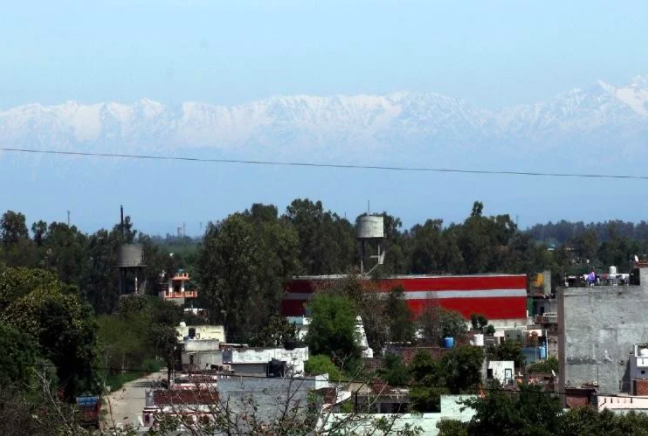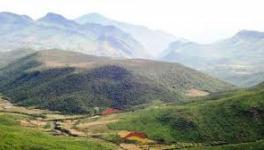Environment & COVID-19 in India: Balancing a Clean Environment with Social Justice

Credit: Amar Ujala
Every year, as winter approaches Delhi and most of north India, at a time when air pollution reaches its peak, newspapers and TV channels are full of detailed analyses and talk shows about high air pollution levels. Different sources of air pollution are mentioned – various factors influencing higher or lower air pollution levels such as seasonal variations, inversion factor in winter, wind etc. – and all kinds of measures that may be undertaken to tackle this problem.
However, intentionally or unintentionally, government agencies, most media outlets and probably therefore even discourse among the general public, fail to pin-point the major causes of this air pollution. If there was ever any real doubt about these major causes, they should have disappeared during the COVID-19 lockdown, especially before restrictions began to be gradually lifted.
With no personal vehicles on the road and only a few trucks on highways carrying essential goods, air pollution over most cities came down drastically. For instance, the Air Quality Index in Delhi was between 30 to 40 in late March and early April this year, as compared to around 180 to 200 at this time last year.
People in Jalandhar in Punjab, and Saharanpur in Uttarakhand, could see the distant Himalayas for the first time in almost 50 years due to the absence of smog and dust haze. Similar photographs of clear air, monuments visible from afar, clear views of empty streets and vistas, appeared in various publications. The shutdown of factories would also have contributed but, notably, thermal power plants were all running, although with lower outputs. However, the main reason was obvious: less vehicular traffic and road dust kicked up by vehicles.
The Peoples Science Movement has been highlighting this simple fact about the basic and major causes of air pollution over the past several years, namely that while other contributory factors also exist, especially in specific local areas, vehicular pollution and related road dust are its main cause in cities. Popular campaigns should, therefore, also be framed around these, and our primary demands should be to increase low-pollution mass public transport, reduce the number of personal vehicles on the roads, promote pedestrian and non-motorised transportation and suitably re-designed urban infrastructure centres, including significantly expanded urban commons such as green spaces, public parks, clean water bodies and plenty of trees. Of late, many mass organisations and other popular movements have increasingly focused on these issues.
Unfortunately, over the past few weeks, with the lifting of restrictions and the resumption of economic and office activity, road traffic has been steadily increasing and the AQI index in most large cities reads over 250. This is particularly dangerous at this time when COVID-19 is still among us; cases are rising and India is nowhere near its peak. Air pollution is already known to cause lakhs of deaths and various respiratory ailments every year. One of the major COVID-19 symptoms are respiratory problems. Therefore, COVID-19 will worsen pulmonary diseases, and air pollution will contribute to increased deaths due to COVID-19. Some agencies have estimated that an increase of one micro-gram/cubic metre (1 µg/m3) of PM 2.5 particles in the air may increase COVID-related deaths by six per cent.
Water pollution has significantly reduced during the lockdown period as well. It is due to the shutting down of industries and even some housing complexes which are notorious for releasing untreated effluents into rivers, lakes, ponds and other water bodies. Unfortunately, untreated sewage continued to flow into water bodies in most cities, including the nation’s capital, and many cities along the mighty and “holy” Ganga, despite many thousands of crores being literally poured down the drain in “Clean Ganga” or “Namami Gange” programmes.
Testing of the Ganga at Haridwar and elsewhere by the CPCB (Central Pollution Control Board), IIT-Roorkee and other agencies had shown a marked improvement in water quality a month after the imposition of the lockdown. The Ganga looked blue at Rishikesh and its waters were fit for bathing and supporting aquatic life at Haridwar, with at least a 50% improvement in dissolved oxygen (DO), 500% less TDS (total dissolved solids), and a reduction in BOD (Biological Oxygen Demand), although reports that the water was fit for achaman (ritual drinking) were clearly exaggerated. Even much further downstream, at Varanasi, similar improvements were noted. Garbage and plastic dumped into the river had also drastically come down. Industries situated along the river banks were shut, and the numerous hotels, dharamshalas and lodges in Rishikesh and Haridwar, many of which discharged raw sewage directly into the Ganga, were also shut.
Even in Delhi, the Yamuna looked clear and blue, with the DO more than 5 mg/litre, rendering it fit for bathing. It was again due to the absence of industrial effluents from Delhi and its neighbouring States.
During the lockdown, with almost no vehicular movement and people mostly staying indoors, leading to much lower noise pollution, various birds that were not usually seen, have not only been visible in cities, but could also be heard. Bird song in urban areas during the lockdown was like a starry sky in rural or remote areas with no light pollution – when a city-dweller sees stars they have rarely, if ever, seen.
Wildlife, normally in hiding from bustling, noisy, intrusive and even invasive human activity, emerged into the open once again. During the lockdown, wild animals came, sometimes in large numbers, on to highways and into cities and towns, into areas that were once their habitat but had been invaded and taken over by humans. Mithun, or the Indian Bison, was seen wandering on highways in different parts of the country, and civet cats wandered into towns in Kerala.
All of this sounds pleasing, and many readers may say: “I wish things would be like this for ever.” Really?
With the easing of lockdown restrictions, the situation is going back to business as usual; cities are witnessing traffic jams, the AQI is climbing again, and rivers are dirty again.
Importantly, all that clean air, less-polluted water and happy wildlife came at a huge cost. With the entire economy shut, migrant workers, daily wagers, domestic help, self-employed artisans and technical service personnel, suffered untold misery which has not ended yet. Those who make the maximum contribution to the Indian economy for the lowest incomes, found themselves without earnings, without food and without shelter, as landlords evicted them because they could not pay rent. Cities, which they built and contributed to running, suddenly simply disowned them. Visuals of migrant workers travelling back to their native villages over thousands of kilometers on foot, with little or no money or food, or packed into trucks risking the COVID-19 infection while also paying enormous amounts, will haunt this country forever.
Must a clean environment involve stopping all economic activity, for which the poor will bear the highest burden? Surely not. This is clearly not sustainable.
Obviously, post-COVID-19, we should not go back to business-as-usual, but given the present structure of the economy and society, we probably will. However, we do need to think about, and work hard towards, a new normal, sooner rather than later. A new normal where economic activity can be conducted in an environment-friendly manner, with less energy and less fossil fuel-based energy; where the poor also have access to clean electricity, clean cooking fuels and appliances, mass public transport, clean and hygienic living conditions, decent jobs at decent wages, and effective social security that can be of help in crises like this one.
Unfortunately, at precisely this time, with people’s attention focused on COVID-19 and related economic and social issues, the government is further diluting environmental regulation as in the proposed Draft Environmental Impact Assessment (EIA) Notification 2020, approving environmentally destructive projects including hydro-electric projects in the North-East, various mining projects in wildlife-rich areas and infrastructure projects in ecologically fragile regions.
The big lesson on World Environment Day during the COVID-19 pandemic is humanity. And certainly, this country needs a clean, sustainable environment, and social justice. One cannot and should not happen without the other.
Get the latest reports & analysis with people's perspective on Protests, movements & deep analytical videos, discussions of the current affairs in your Telegram app. Subscribe to NewsClick's Telegram channel & get Real-Time updates on stories, as they get published on our website.
























